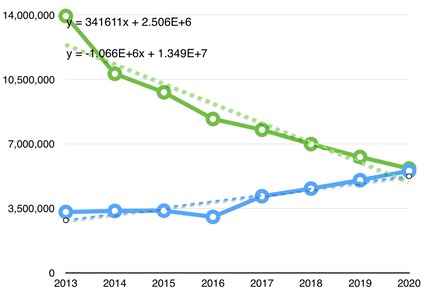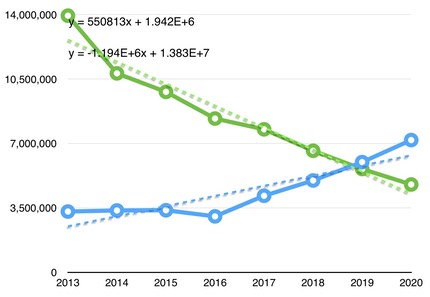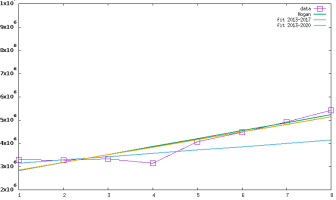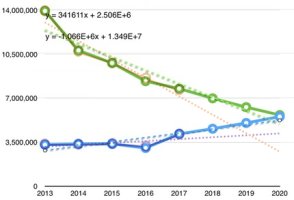neuroanatomist said:
Hflm said:
Regarding the job, I do a lot of data analysis (big data, huge simulations (exascale), etc.), so I think you don't need to assume what I know or don't know. You didn't even bother to read about the assumptions of Hogans analysis and boast about others looking foolish etc.
Yes, I read Hogan's assumptions and his description of how he generated the plots. If you indeed read his blog post (and you certainly imply that you have done so), it's apparent that you cannot properly comprehend what you read. There's no need to assume what you don't know, when you demonstrate what you don't know right here in this thread and succeed in making yourself look foolish in the process.
Let's review:
Hflm said:
The thing is, that using the existing data and calculating trend lines over this period is not what Thom Hogan did. He didn't estimate the 2020 data based on a trend of _only_ the old data.
Instead he first estimated, based on a simple reasonable assumption, the unit volume for 2018, 2019 and 2020, assuming that MILCs grow in Volume by 10% each year from now on, as well as DSLRs decline by 10% each year. Then he calculated trend lines from 2013 to 2020 based on the model to estimate a cross-over-point.
I find that a very reasonable model.
[quote author=Thom Hogan]
The straight linear trend looks like this (hashed lines; the solid lines are actual through 2017, linear estimates through 2020).
Note that 2016 was a problem for mirrorless due to sensor shortages due to the earthquake.
Implied in this graph is about a 10% drop in DSLR unit volume a year and a 10% gain in mirrorless unit volume (the 2017 gain for mirrorless was 25% [current trailing year numbers], but it was also a recovery year from sensor shortages).
But a linear trend is not necessarily what we'll see. In fact, it's highly unlikely that sales would progress linearly. As more mirrorless choices become available and it becomes clear that Canon and Nikon are endorsing such models, we're likely to see a higher mirrorless adaptation rate. Change the growth rate in mirrorless and the contraction rate in DSLRs by a factor of one point five to two and you get something like this:
He plotted actual data from 2013-2017, generated linear trendlines based on those data which yield a ~10% y/y decrease in dSLRs and a ~10% y/y increase in MILC shipments (actually, the latter closer to ~6% per year), which he then extrapolated to 2018-2020 based on those linear trendlines. In other words, using the
existing data and calculating trend lines over this period is
_exactly_ what Thom Hogan did (as he stated and I highlighted in
red above). There is no 'assumption of a 10% decline/growth'
prior to calculating the trendlines, as you erroneously suggest. The 10% decline/growth
are based on the trendlines generated from the 2013-2017 actual data. In that scenario, the trendlines would cross in 2020.
He
then made an assumption that the 10% growth/decline in MILCs/dSLRs (respectively) was an underestimate (based on new MILCs from Canon and Nikon), and modeled what would happen if those rates increased 1.5- to 2-fold, i.e. a 15-20% y/y growth/decline in MILCs/dSLRs (respectively). With that assumption, the steeper trendlines would cross in 2019.
But...my original point still stands. He based his straight linear trends on actual data from
2013-2017, and for MILCs over that period, the data show the trendline increasing ~10% y/y. That ~10% y/y change is the basis for his MILC projections. Yet, data on MILC shipments are available starting from 2012, and he ignored the 2012 data point – a data point which, had it been included, would have resulted in a
flat trendline for MILCs from 2012-2017...and of course, a 15-20% increase to a flat trendline is...a flat trendline. (But as I also stated, that doesn't apply to the decrease in dSLR shipments from 2012-2017; based on that rate of decline and a logical assumption of MILC growth if Canon continues growing their MILC lines and Nikon enters the fray, a crossover point of 2019-2020 remains a reasonable possibility, even if Hogan arrived at that conclusion through flawed methods.)
If your failure to fully grasp and correctly describe Thom Hogan's analysis is representative of your overall scientific acumen, I feel sorry for your students and for anyone relying on your data analysis.
[/quote]
You say "He plotted actual data from 2013-2017, generated linear trendlines based on those data which yield a ~10% y/y decrease in dSLRs and a ~10% y/y increase in MILC shipments (actually, the latter closer to ~6% per year),
which he then extrapolated to 2018-2020 based on those linear trendlines. In other words, using the existing data and calculating trend lines over this period is _exactly_ what Thom Hogan did"
No.
It makes a difference whether it is 6% or 10%. The data is _not_ extrapolated to 2020 based on the trend line from the data from 2013 to 2017. The attached image reproduces the data and trend lines, based on your numbers given in a previous thread, just to get a quick dataset at hand.
As you can see, when calculating a trend for the data assuming a 10% increase per year for the subsequent 3 years (equivalent to a linear trend from 2017 to 2020, which is what he meant and highlighted in your red bold text), I can almost exactly reproduce Thom Hogan's trend line. So our datasets are very similar.
Given, too, is the trend line based on the 2013-2017 data alone. A clear difference in slope. The data values from 2018 to 2020 would have been much lower, had I estimated them given the 2013-2017 trend.
You can see that by comparing the slope of the trend line and data, that they are different for that region, too.





